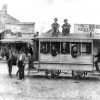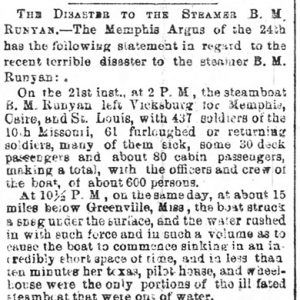calsfoundation@cals.org
B. M. Runyan [Steamboat]
The steamboat B. M. Runyan was carrying a regiment of Union soldiers when it struck a snag in the Mississippi River off Chicot County on July 21, 1864, and sank, killing as many as 150 people.
The B. M. Runyan was a sidewheel paddleboat built in Cincinnati, Ohio, in 1858 for Captain James Miller and his partners, who intended to use it for runs between Cincinnati and New Orleans, Louisiana. A Mr. Mitchell of Alton, Illinois, bought the Runyan in June 1862 for voyages between Alton and St. Louis, Missouri. The vessel sank in shallow waters below Alton that December and was raised and sent to St. Louis for repairs. Returned to service in 1864, the B. M. Runyan again began making runs to the lower Mississippi River.
The Runyan started north from Vicksburg, Mississippi, around 2:00 p.m. on July 21, 1864, carrying 437 men of the Tenth Missouri Cavalry (US), sixty-one other soldiers, and around thirty cabin and eighty deck passengers—around 600 people, in all; many of the soldiers were heading to Cairo, Illinois, to muster out of service. Between 10:00 and 11:00 p.m., as the steamboat neared Island 84 near Gaines’ Landing (Chicot County), it hit a snag in the river.
Within ten minutes, the B. M. Runyan had sunk so much that only the Texas deck, pilot house, and wheelhouse were above water, and the steamboat began to break apart. A passenger reported that, as the Runyan sank, many of its passengers rushed toward the hurricane deck, but “the balance, and by far the largest number, took to the water. Many, unable to swim, in the excitement of the moment, threw themselves in without even a piece of wood, plank, or anything that could assist them in floating, and of course only rushed to destruction.”
The deck of the steamboat broke free from the sunken hull and began floating downstream. By chance, the gunboat USS Prairie Bird saw the accident and rushed forward to rescue the stricken passengers. Lieutenant Commander E. K. Owen reported that the gunboat “succeeded in saving about 350. About 150 were drowned.”
The surviving cabin passengers were taken aboard the steamboat James White the next day, and the remainder were placed on the ships of the Mississippi Marine Brigade to continue upriver. Also lost in the disaster were more than 100 mules, sixty-two horses, fifteen wagons, and all of the equipment of the Tenth Missouri Cavalry. The cost in government supplies was estimated as high as $200,000. The deck lodged in a sandbar at American Cut-off and was burned by Union troops to keep Confederates from making use of it.
Estimates of the death toll in the sinking of the B. M. Runyan vary between seventy and 150 lives lost.
The B. M. Runyan catastrophe provides another illustration of the dangers of steamboat travel in Arkansas waters in the nineteenth century, when encounters with snags also caused mass casualties on the Belle Zane in 1845, the John Adams in 1851, the Cambridge in 1862, the Mercury in 1867, the G. A. Thompson in 1869, and the Nick Wall in 1870.
For additional information:
“Destruction of a Steamer on the Mississippi.” Star and Enterprise [Newville, Pennsylvania], July 30, 1864, p. 2.
“The Disaster to the Steamer B. M. Runyan.” Courier-Journal [Louisville, Kentucky], July 29, 1864, p. 1.
Simons, Don R. In Their Words: A Chronology of the Civil War in Chicot County, Arkansas and Adjacent Waters of the Mississippi River. Lake Village, AR: D. R. Simons, 1999.
“Terrible Steamboat Accident.” New York Daily Herald, July 31, 1864, p. 2.
The War of the Rebellion: A Compilation of the Official Records of the Union and Confederate Navies. Vol. 26, pp. 485–486. Washington DC: Government Printing Office, 1914.
Way, Frederick, Jr. Way’s Packet Directory. Athens: Ohio University Press, 1983.
Mark K. Christ
Central Arkansas Library System


 B. M. Runyan Disaster Article
B. M. Runyan Disaster Article 



Comments
No comments on this entry yet.